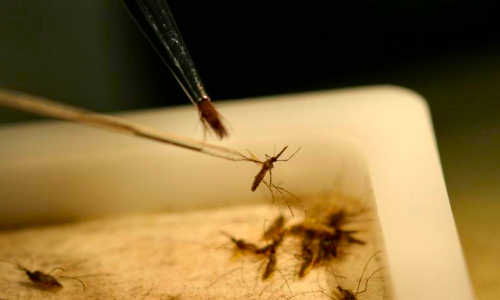If you were about to enter a crowded subway during flu season, packed with people sneezing and coughing, wouldn’t it be helpful if your immune system recognized the potentially risky situation and bolstered its defenses upon stepping into the train?
According to a new study by University of Pennsylvania and Imperial College London researchers, the mosquito immune system does something similar. After ingesting a meal of blood, mosquitoes ramp up production of immune system proteins that help fight off the parasites that blood might contain.
“This appears to be a new mechanism by which the mosquito is anticipating a parasite infection,” said Michael Povelones, an assistant professor in Penn’s School of Veterinary Medicine, who co-authored the study.
Povelones collaborated on the work, published in the January issue of the Journal of Innate Immunity, with Imperial College London researchers Leanna M. Upton, a research associate, and George K. Christophides, a professor and chair of infectious diseases and immunity.
Povelones has spent many years studying the interplay between mosquitoes and parasites. While it’s easy to think about mosquitoes as a mere portal for shuttling malaria and other diseases from one person to another, the insects themselves have their own immune response to infection. A greater understanding of how mosquitoes naturally fight off infection could offer a strategy for preventing humans from getting infected with those same pathogens.
“With malaria and other vector-borne diseases, we’re faced with problems of not having effective vaccines, drug-resistant parasites and insecticide-resistant vectors. But as it turns out, mosquitoes do a great job of controlling infection in their own bodies,” said Povelones. “If we can use that information to our advantage, we might be able to find new avenues of preventing mosquitoes from transmitting disease.”
Researchers already knew that a group of molecules called leucine-rich repeat immune proteins, or LRIMs, were important players in mosquitoes’ immune defense. In a paper published in 2009 in Science, Povelones, Christophides and colleagues reported that two of these LRIMs, LRIM1 and APL1C, are part of a signaling pathway akin to the human complement system, which coordinates immune response through a cascade of signaling interactions. In mosquitoes, LRIM1 and APL1C helped target malarial parasites for destruction.
In the current study, the researchers wanted to gain a deeper understanding of what the other identified LRIM proteins—there are at least two dozen—did for mosquito immunity.
Using RNA inhibitors, which block production of particular RNA transcripts, they “turned off” one LRIM at a time in live Anopheles gambiae mosquitoes. Then, they exposed the insects to Plasmodium berghei, a parasite that is related to Plasmodium falciparum, which causes malaria in humans. The P. berghei parasite only infects mammals other than humans, making it a good, safe model for studying malaria.
From their tests, one protein, LRIM9, stood out. When it was blocked, parasite levels in the mosquitoes increased three-fold. And they found that adult females had the highest expression levels of LRIM9, with more than 20 times the amount of LRIM9 as adult males. LRIM9 RNA expression was also low in earlier life stages, such as in eggs and pupae.
“That was the first good clue that we were looking at something unique that we hadn’t seen before,” Povelones said. “That turned the focus toward blood feeding.”
Adult females are the only mosquitoes that drink blood, leading the researchers to consider whether it was something about this meal that triggered activation of LRIM9.
The team fed mosquitoes blood from mice that were either infected with P. berghei or were uninfected. No matter whether the insects drank the infected or uninfected blood, LRIM9 levels surged 48 hours after their meal.
That finding still left open the possibility that there were pathogens besides P. berghei in the blood to which LRIM9 was responding. Previous research had shown that bacteria enter the mosquito’s gut following blood meals, dramatically expanding the population of microbes already present. But Povelones and colleagues found that LRIM9 levels rose even when the mosquitoes were given antibiotics before feeding, indicating that the bacteria weren’t responsible for triggering LRIM9.
Since it appeared that the parasites and bacteria weren’t responsible for activating LRIM9, the researchers considered whether hormones might be playing a role. They zeroed in on ecdysone, a steroid hormone secreted by the ovaries after blood feeding that regulates genes important to reproduction.
After injecting mosquitoes with 20E, the biologically active form of ecdysone, the team observed an increase in production of the LRIM9 protein.
Though ecdysone is associated with reproduction, and specifically egg formation, in mosquitoes, the researchers found that LRIM9 did not impact reproductive success. It also did not affect the mosquitoes’ digestion.
In a final query, the researchers checked to see whether LRIM9 acted in the same pathway as LRIM1 and APL1C, but found no evidence to support its involvement.
“We can’t be 100 percent sure we’re dealing with a new pathway, but it doesn’t seem to be related to the system we already knew about,” Povelones said.
Povelones and colleagues believe that LRIM9 may help the mosquito immune system recognize pathogens and may also recruit or interact with other immune system components. Thus beefing up its levels could quicken an immune response, before a parasite is even detected.
“It could be that LRIM9 is a good illustration of how this anticipatory system works, but it might not be the whole story,” Povelones said.
The researchers plan to continue investigating how ecdysone may help mosquitoes gird against infection.
“I expect this hormone might play a broader role in regulating mosquito immunity,” Povelones said.
Story Source:
The above story is based on materials provided by University of Pennsylvania





